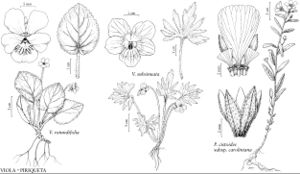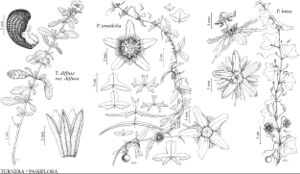Herbs, subshrubs, or shrubs [trees], perennial, often rhizomatous. Stems usually branched, hairs simple and/or porrect-stellate [stellate] and, sometimes, glandular-hairs. Leaves alternate, sessile or petiolate; stipules present or absent; blade margins crenate or serrate filiform; stigmas 3, penicillate. Fruits capsular, 3-valved, dehiscence loculicidal. Seeds obovoid, straight or curved; aril inserted around hilum, lobed, plump, membranous when dry; endosperm fleshy; embryo straight.
Distribution
sc, se United States, Mexico, West Indies, Central America, South America, Africa, Indian Ocean Islands (Madagascar), Indian Ocean Islands (Mascarene Islands)
Discussion
Genera 10, species 226 (2 genera, 4 species in the flora).
The close relationships of Turneraceae with Passifloraceae, Malesherbiaceae, and Violaceae have long been recognized, especially by the presence of cyclopentenoid cyanogenic glycosides and cyclopentenyl fatty acids. These families have traditionally been positioned in Parietales or Violales with other taxa that have parietal placentation; analyses of DNA sequence data indicate that only a subset of the taxa with parietal placentation are closely related. The group that includes Turneraceae is embedded within Malpighiales (V. Savolainen et al. 2000b; D. E. Soltis et al. 2000; O. I. Nandi et al. 1998; M. W. Chase et al. 2002).
Selected References
Illustrations
Key
| 1 | Hairs porrect-stellate and simple, seldom absent, glandular hairs absent; leaves without nectaries; peduncle free; corona present. | Piriqueta |
| 1 | Hairs glandular and simple, glandular hairs microcapitate or sessile-capitate; leaves often with nectaries; peduncle free or adnate to petiole (flowers epiphyllous); corona absent. | Turnera |

